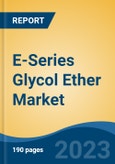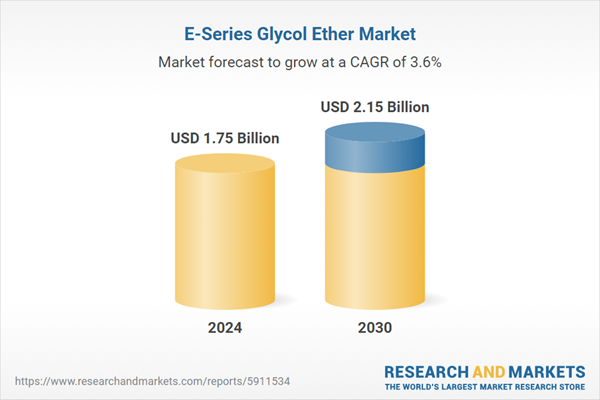Speak directly to the analyst to clarify any post sales queries you may have.
10% Free customizationThis report comes with 10% free customization, enabling you to add data that meets your specific business needs.
Key Market Drivers
Growing Demand of E-Series Glycol Ether from Paints & Coatings Industry
E-Series Glycol Ethers are highly versatile solvents widely utilized across multiple industries, including paints and coatings, printing inks, cleaners, and electronics. Known for their excellent solvency, chemical stability, low volatility, and compatibility with both water and a wide range of organic solvents, these compounds play a crucial role in enhancing product performance and formulation efficiency.Among the various applications, the paints and coatings industry represents one of the largest consumers of E-Series Glycol Ethers. These solvents are valued for their ability to improve key properties of paint formulations, such as flow, leveling, and gloss. By controlling the evaporation rate, they help prevent premature drying, ensuring smoother application and uniform film formation. Their effectiveness in water-based systems makes them a preferred choice in environmentally friendly and low-VOC (volatile organic compound) coatings.
The global demand for paints and coatings has grown significantly in recent years, primarily driven by rapid urbanization, infrastructure development, and rising automotive production. Emerging economies in Asia-Pacific, the Middle East, and Latin America are witnessing increased construction activity, further boosting demand for architectural and industrial coatings. As a result, the use of E-Series Glycol Ethers in this sector has risen substantially. Global construction output is projected to grow significantly, rising from USD 9.7 trillion in 2022 to USD 13.9 trillion by 2037. This growth is primarily driven by the robust expansion of major construction markets, including China, the United States, and India, which continue to invest heavily in infrastructure development and urbanization.
Beyond paints and coatings, E-Series Glycol Ethers are also used in cleaning products, where they serve as efficient degreasers and coupling agents. In electronics, they are used in the manufacture of photoresists and cleaning agents for precision components. These diverse end-use applications reinforce the importance of these solvents in various industrial and consumer goods.
The growing demand from the paints and coatings industry remains a key driver of the global E-Series Glycol Ether market. As the coatings sector continues its upward trajectory, supported by construction growth, automotive advancements, and regulatory shifts toward greener products, the market for E-Series Glycol Ethers is expected to expand steadily. With their proven performance, formulation versatility, and environmental compliance, these solvents are well-positioned to support the evolving needs of a wide range of industries in the years ahead.
Key Market Challenges
Volatility in Price of Raw Materials
The cost of raw materials represents a significant portion of the total production cost for E-Series Glycol Ethers. These costs are subject to fluctuations influenced by factors such as supply chain disruptions, shifts in global demand, and currency exchange rate variations. For example, in June 2022, data showed that raw material prices paid by Canadian manufacturers rose by 37% year over year. Such substantial increases directly impact the production costs of E-Series Glycol Ethers, making them more expensive to produce and ultimately more costly for end-users.This volatility in raw material prices can have several implications for the E-Series Glycol Ether market. Increased production costs may reduce manufacturers’ profit margins, forcing them to reassess pricing strategies or delay investments in innovation and capacity expansion. Smaller margins can also discourage new market entrants, limiting competition and potentially slowing industry growth.
If manufacturers pass these additional costs on to consumers, it may lead to decreased demand, especially if customers opt for more affordable alternatives. This shift could negatively impact the market share and growth trajectory of E-Series Glycol Ethers. If manufacturers choose to absorb rising input costs to maintain market share, it could erode profitability and strain financial resources, potentially hindering R&D investments and long-term competitiveness.
Key Market Trends
Shift Towards Water-Based Formulations
Water-based formulations, which are characterized by water being the primary solvent, have gained substantial momentum across various industries. The key driving factor behind their growing popularity lies in their lower Volatile Organic Compound (VOC) content compared to solvent-based alternatives. This reduction in VOCs not only minimizes the environmental impact but also enhances safety profiles, making these formulations highly appealing to both industries and consumers alike.In the realm of water-based formulations, E-Series Glycol Ethers play a pivotal role owing to their exceptional solvency, coalescing abilities, and compatibility with water. These properties have significantly contributed to the surging demand for E-Series Glycol Ethers, consequently fueling the growth of the global market. A noteworthy trend that has emerged in this market is the increasing shift towards water-based coatings, primarily driven by mounting environmental concerns and regulatory pressures. Notably, E-Series Glycol Ethers are extensively utilized as solvents in these water-based coatings, thereby propelling their demand to new heights.
As industries strive to prioritize sustainability, the trend towards water-based formulations is expected to persist and even intensify in the foreseeable future. This enduring trend is anticipated to continue driving the demand for E-Series Glycol Ethers. The development of bio-based and eco-friendly glycol ethers holds promising potential for creating additional growth opportunities within the market. The shift towards water-based formulations stands as a significant and transformative trend in the global E-Series Glycol Ether market. As industries continue to prioritize sustainability and regulatory compliance, this trend is poised to further propel the growth and expansion of this dynamic market.
Key Market Players
- Eastman Chemical Co
- Huntsman Corporation
- Saudi Basic Industries Corporation (SABIC)
- LyondellBasell Chemical Company
- India Glycols Limited
- Shell Chemical LP
- Exxon Mobil Corporation
- Sasol Ltd.
- BASF SE
- Dow Inc.
Report Scope:
In this report, the Global E-Series Glycol Ether Market has been segmented into the following categories, in addition to the industry trends which have also been detailed below:E-Series Glycol Ether Market, By Type:
- Ethylene Glycol Propyl Ether
- Ethylene Glycol Butyl Ether
- Ethylene Glycol Butyl Ether Acetate
- Others
E-Series Glycol Ether Market, By Application:
- Paints & Coatings
- Cosmetics & Personal Care
- Pharmaceutical
- Automotive
- Others
E-Series Glycol Ether Market, By Region:
- North America
- United States
- Canada
- Mexico
- Europe
- France
- United Kingdom
- Italy
- Germany
- Spain
- Asia-Pacific
- China
- India
- Japan
- Australia
- South Korea
- South America
- Brazil
- Argentina
- Colombia
- Middle East & Africa
- South Africa
- Saudi Arabia
- UAE
- Egypt
Competitive Landscape
Company Profiles: Detailed analysis of the major companies present in the Global E-Series Glycol Ether Market.Available Customizations:
With the given market data, the publisher offers customizations according to a company's specific needs. The following customization options are available for the report.Company Information
- Detailed analysis and profiling of additional market players (up to five).
This product will be delivered within 1-3 business days.
Table of Contents
Companies Mentioned
- Eastman Chemical Co
- Huntsman Corporation
- Saudi Basic Industries Corporation (SABIC)
- LyondellBasell Chemical Company
- India Glycols Limited
- Shell Chemical LP
- Exxon Mobil Corporation
- Sasol Ltd.
- BASF SE
- Dow Inc.
Table Information
| Report Attribute | Details |
|---|---|
| No. of Pages | 185 |
| Published | July 2025 |
| Forecast Period | 2024 - 2030 |
| Estimated Market Value ( USD | $ 1.75 Billion |
| Forecasted Market Value ( USD | $ 2.15 Billion |
| Compound Annual Growth Rate | 3.6% |
| Regions Covered | Global |
| No. of Companies Mentioned | 10 |









